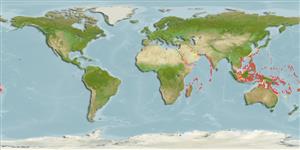Hexacorallia |
Scleractinia |
Merulinidae
Environment: milieu / climate zone / djupintervall / distribution range
Ekologi
Revassocierade; djupintervall 0 - 30 m (Ref. 848). Tropical; 36°N - 34°S, 26°E - 172°W (Ref. 848)
Indo-West Pacific.
Length at first maturity / Size / Weight / Age
Könsmognad: Lm ? range ? - ? cm
Colony: massive, hemispherical, flat, or columnar; commonly over 1 m across. Corallites: 4 to 6 sided. Long and short septa alternate clearly; thin and straight with well developed thin paliform lobes. Color: uniform cream or pale brown, sometimes brown, pink, or green (Ref. 848).
Sometimes a dominant species of intertidal habitats (Ref. 848).
Life cycle and mating behavior
Könsmognad | Reproduktion | Lek | Eggs | Fecundity | Larvae
Hermaphroditic (Refs. 113708, 113712). Mature gametes are shed into the coelenteron and spawned through the mouth. Life cycle: The zygote develops into a planktonic planula larva. Metamorphosis begins with early morphogenesis of tentacles, septa and pharynx before larval settlement on the aboral end (Ref.833).
Babcock, R.C. 2003 Identification of Sclerectinian Coral Recruits from Indo-Pacific Reefs. Zoological Studies 42 (1):211-226. (Ref. 791)
IUCN Red List Status
(Ref. 130435: Version 2025-1)
CITES status (Ref. 108899)
Not Evaluated
Threat to humans
Human uses
| FishSource |
Verktyg
Ytterligare information
Trophic EcologyFood items (preys)FödosammansättningFödointagPredatorer PhysiologySyreförbrukning
Human RelatedStamps, coins, misc.
Internet-källor
Estimates based on models
Preferred temperature
(Ref.
115969): 25.3 - 29.3, mean 28.6 (based on 2013 cells).
Price category
Unknown.
